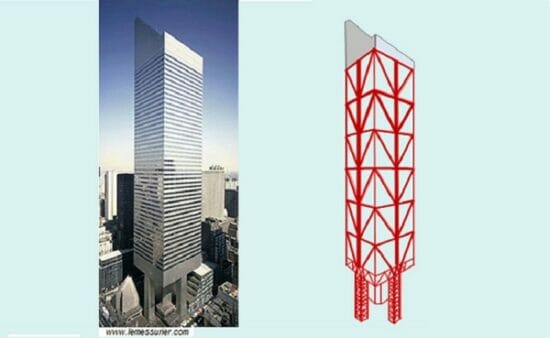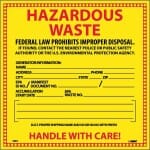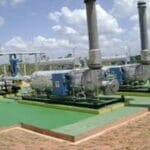- Course No E – 1950
- PDH Units: 2
No data found for Custom Course Number
No data found for Custom Course Units
Intended Audience: All Engineers
PDH UNITS: 2
The 59-story Citicorp Tower in New York, now renamed 601 Lexington Tower, was completed in 1977. The tower has a unique steel structure with perimeter mega-braced frames and a V-braced core. The perimeter mega-braced frame is supported on four 9-story tall mega columns at the base. The mega-columns are located at the center of each side of the structure instead of at the corners, which is the case for the most skyscraper. The reason for mega-columns not being placed at the corners was the presence of a church on the NW corner of the site. The perimeter mega-braced frame carries about one-half of the gravity load and all wind loads. The core framing carries the other half of the gravity load. Less than a year after the completion of the tower, it was discovered that the mega brace splices do not have the code-required factor of safety and the structure is in danger of collapse during a hurricane. An emergency retrofit plan was developed and implemented to strengthen the mega-brace weak splices in two months before any hurricane hit the tower. The first part of this course will discuss the unique structural system of the tower, why the mega-brace joints ended up being weak, and what was done to strengthen them. The second part will focus on the engineering ethical issues of wind retrofit. For years, this case was considered a good example of ethical conduct by all involved, especially by the late William LeMessurier, the lead structural engineer of the tower. However, in recent years, a few articles have argued the opposite declaring LeMessurier in violation of several canons of the Code of Ethics for Engineers. After spending more than 300 hours researching the subject, reviewing almost all publicly available documents and videos on the subject, and doing a full-fledged SAP analysis of the structural system, Dr. Astaneh will present factual information on what was the problem, how the problem was discovered, and the details of the main steps taken by William LeMessurier from the moment of discovery of the problem until the completion of the needed retrofit. He will also examine the validity of the statements on unethical conduct by William LeMessurier and others involved in the emergency retrofit. The main conclusion of this webinar, supported by the evidence presented during the webinar, is that not only William LeMessurier did not act unethically, but, he set an example of how facing the inevitable fast-approaching catastrophe, he considered “safety to be paramount”, managed to develop a doable solution in a matter of days, and convinced all other stakeholders, especially the owner, to support and finance the retrofit, which was done in about two months before the hurricane season rolled in in full power. References and Recommended Further Readings:
- Code of Ethics of National Society of Professional Engineers (NSPE) (PDF)
- NSPE Ethics Reference Guide (PDF)
- Ethics, Technology, and Engineering, a 2011 book by Ibo van de Poel and Lambèr Royakkers, Wily-Blackwell. (Amazon page)
- Concepts and Cases-Engineering Ethics, a 2019 book by Charles E. Harris et al., published by Cengage. (Amazon page)
- The Ethical Executive, a 2010 book by Robert Hoyk and Paul Hersey, Stanford Business Books. (Amazon page)
- Joe Morgenstern (1995), “The Fifty-Nine- story Crisis”, The New Yorker, May 29, 1995. Pages 45–53.
- Eugene Kremer (2002). “(Re)Examining the Citicorp Case: Ethical Paragon or Chimera”, Cross Currents, Fall 2002, Vol. 52, No 3. Brady, S. (2014, February).
- Citicorp Center Tower: failure averted. The Structural Engineer, pp. 14–15.
- LeMessurier, William J. “The 59 Story Crisis: A Lesson In Professional Behavior” (video November 17,1995).
Learning Objectives:
At the successful conclusion of this course, you will learn the following knowledge and skills:- The structure of the Citicorp Tower.
- The root cause of the problem of mega-brace splices being weak.
- The solution to strengthen the mega-brace splices and how it was implemented.
- The ethical issues related to the problem of the mega-brace splices and the solution to retrofit them.
- Why the conduct of the late William LeMessurier, the lead structural engineer of the Citicorp Tower is an example of excellent ethical conduct of an engineer saving thousands of lives from a certain catastrophe.
Course Reviews
5
- 5 stars1
- 4 stars0
- 3 stars0
- 2 stars0
- 1 stars0
Once completed, your order and certificate of completion will be available in your profile when you’re logged in to the site.











Excellent